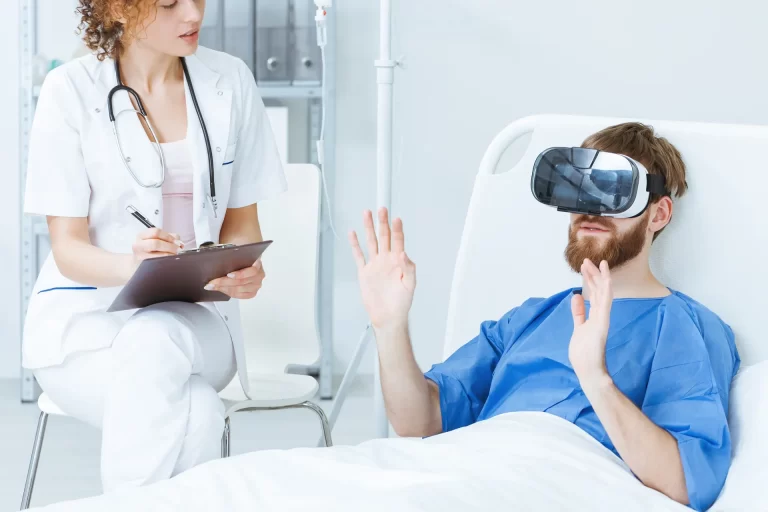Wichtige Punkte
- VR physical therapy enhances engagement, mobility, and adherence.
- Virtual reality rehabilitation shows measurable benefits across pain, function, and balance—with real-time feedback and personalization.
- Applications span stroke rehabilitation VR, orthopedic recovery, and home-based VR rehab technology.
- Challenges include cost, motion sickness, accessibility, and limited protocols.
Virtual Reality Moves From Gaming to Healing: Why VR Physical Therapy Is Entering a New Era
Virtual reality was once seen as a gaming novelty, but in recent years, it has found a serious role in healthcare. Instead of fantasy landscapes, VR physical therapy immerses users in carefully designed environments where every movement matters. Stepping over virtual logs or reaching for digital targets becomes structured exercise—activating muscles, retraining balance, and improving coordination. This gamified but science-driven approach makes therapy more engaging, which is crucial for long-term recovery (MDPI, 2024).
Global reports predict rehabilitation will be one of the fastest-growing sectors for VR in healthcare, with billions in projected market value. What makes this growth notable is that VR doesn’t just digitize existing exercises; it reimagines them. By merging data-driven tracking with immersive engagement, VR physical therapy combines precision with motivation, making recovery both effective and enjoyable (U.S. Department of Veterans Affairs, 2024).
Why VR Physical Therapy Matters for Recovery
Millions face mobility challenges each year—from post-surgical recovery to stroke rehabilitation. Traditional therapy is effective but often repetitive and discouraging. VR rehab technology offers a way to increase adherence by blending exercise with immersive, task-oriented scenarios (BMC Musculoskeletal Disorders, 2024).
Adherence is critical, yet up to half of users drop out of prescribed programs. VR physical therapy addresses this by making exercises purposeful and trackable. Health professionals can also monitor progress remotely, tailoring plans more effectively (Games for Health Journal, 2018).
The Hidden Challenges of Traditional Rehab That Virtual Reality Helps Solve
- Boredom and disengagement: Repetition reduces motivation.
- Physical discomfort: Pain and stiffness make adherence harder.
- Access barriers: Travel is difficult for many users.
- Limited personalization: Traditional programs may not adapt to individual needs.
Virtual reality rehabilitation introduces variety and personalization, adjusting exercises to ability levels and reducing the perception of effort. This makes therapy feel less like a burden and more like meaningful progress (Virtual Reality, 2022).
How VR Physical Therapy Works: The Science Behind Immersive Rehabilitation
VR combines motion tracking, biofeedback, and personalized environments. Sensors capture joint mechanics while headsets provide real-time feedback, strengthening neuromuscular pathways and improving proprioception (MDPI, 2024).
In stroke rehabilitation VR, reaching for virtual objects retrains weakened limbs (Frontiers in Neurology, 2024). In knee replacement recovery VR, gamified balance and mobility exercises improve strength and stability (BMC Musculoskeletal Disorders, 2024). Importantly, VR activates reward pathways in the brain, boosting motivation through gamified achievements (Games for Health Journal, 2018).
Innovative Applications of VR Rehab Technology
- Clinic-based programs integrate VR into supervised sessions, transforming drills into interactive challenges. Shoulder rehab studies show strong engagement, though therapist oversight is still necessary (BMC Musculoskeletal Disorders, 2023).
- Home-based rehabilitation allows users to complete guided sessions remotely with adherence rates exceeding 80 percent (MDPI, 2024).
- Gamified routines—with points, levels, and achievements—help users stick to therapy. One study found adherence rates close to 90 percent with gamified VR compared to traditional home exercise (Games for Health Journal, 2018).
From Knee Replacement Recovery to Stroke Rehabilitation VR: Case Studies
In orthopedic clinics, VR-based therapy for knee replacement improved pain and balance more effectively than conventional therapy alone, with benefits lasting up to six months (Bulletin of Faculty of Physical Therapy, 2024).
Stroke rehabilitation VR has also shown strong results. Immersive, task-oriented programs—such as catching virtual objects—improved upper-limb mobility and daily function, performing as well as or better than traditional therapy (Frontiers in Neurology, 2024). Many users also report less frustration and more motivation, which directly improves adherence.
Barriers to Wider Adoption of VR in Healthcare
Challenges remain before VR physical therapy becomes mainstream. Motion sickness and eye strain affect up to 40 percent of new users (Virtual Reality, 2022). Cost and access remain barriers, especially for smaller clinics. Insurance coverage is inconsistent, and standardized guidelines for safe, effective use are still lacking (U.S. Department of Veterans Affairs, 2024).
Still, as devices become more affordable and evidence continues to mount, adoption is expected to expand.
What Comes Next: Building a Future of Accessible VR Physical Therapy
Health professionals can begin piloting VR in rehabilitation programs while documenting outcomes. Users and caregivers should ask about VR as an adjunct to traditional therapy, especially where motivation or access is an issue. Policymakers and insurers will play a key role in expanding equitable access.
VR physical therapy is not a cure-all, but it represents one of the most promising advances in rehabilitation. By making therapy more engaging and personalized, VR has the potential to transform how we recover mobility, independence, and quality of life.
Der Artikel stellt in keiner Weise eine medizinische Beratung dar. Bitte konsultieren Sie einen zugelassenen Arzt, bevor Sie eine Behandlung beginnen. Diese Website kann Provisionen für die in diesem Artikel erwähnten Links oder Produkte erhalten.
Sources
- BMC Musculoskeletal Disorders. (2023). Virtual reality rehabilitation using Oculus Quest 2 in shoulder therapy. https://bmcmusculoskeletdisord.biomedcentral.com/articles/10.1186/s12891-023-06861-5
- BMC Musculoskeletal Disorders. (2024). Virtual reality rehabilitation after total knee replacement: Systematic review. https://bmcmusculoskeletdisord.biomedcentral.com/articles/10.1186/s12891-023-06861-5
- Bulletin of Faculty of Physical Therapy. (2024). Effectiveness of VR-based rehabilitation after total knee replacement. https://bfpt.springeropen.com/articles/10.1186/s43161-024-00246-y
- Frontiers in Neurology. (2024). Immersive VR in stroke rehabilitation: A systematic review and meta-analysis. https://www.frontiersin.org/journals/neurology
- Games for Health Journal. (2018). Gamified VR and adherence in physical rehabilitation. https://www.sciencedirect.com/science/article/pii/S1934148218303812
- MDPI. (2024). Technologies in physical rehabilitation: A systematic review of virtual reality applications. https://www.mdpi.com/2227-7080/13/5/186
- U.S. Department of Veterans Affairs. (2024). VA immersive technology literature review. https://www.innovation.va.gov/hil/assets/documents/va-immersive-lit-review-2024.pdf
- Virtual Reality. (2022). Barriers to implementation of VR in rehabilitation. https://link.springer.com/article/10.1007/s10055-022-00654-2




VR physio? That looks like fun—wish I had that back in the day